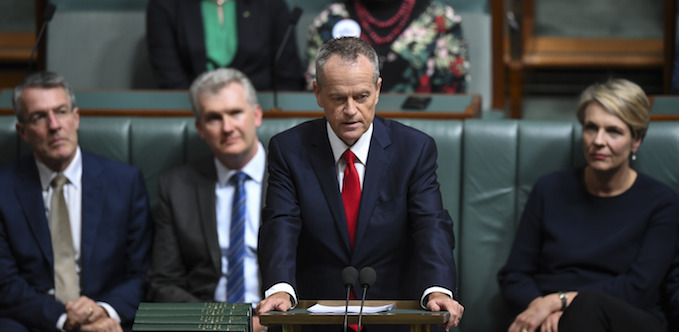
Opposition leader Bill Shorten. Source: AAP/Lukas Coch.
By Michelle Grattan, University of Canberra
Opposition leader Bill Shorten has launched a tax bidding war, promising to top the government’s tax relief for lower and middle income earners, as he prepares to fight a string of by-elections in Labor seats.
The Labor alternative almost doubles the budget’s relief for these taxpayers, incorporating the early part of the government’s plan and then building on it.
Delivering his budget reply in Parliament on Thursday night, Shorten pledged to give bigger income tax cuts for 10 million taxpayers. Some four million would get $398 a year more than the $530 under the government’s plan.
Labor’s “Working Australians Tax Refund”, would cost $5.8 billion more than the government’s plan over the forward estimates.
Labor’s alternative comes as debate intensifies about the latter stage of the government’s plan, when a flattening of the tax scale would give substantial benefit to high income earners.
The ALP hardened its position against that change as modelling cast doubt on its fairness. The opposition launched a Senate inquiry which will report mid-June on the tax legislation, introduced into parliament on Wednesday.
The government says it will not split the bill, which it wants through before parliament rises for its winter break, but will be under pressure to do so including from the crossbench.
Under Shorten’s proposal, the ALP would support the government’s budget tax cut in 2018-19. Once in power, it would then deliver bigger tax cuts from July 1 2019, when it began the refund.
In Labor’s first budget “we will deliver a bigger better and fairer tax cut for 10 million working Australians. Almost double what the government offered on Tuesday”, Shorten told Parliament.
The Labor plan would give all taxpayers earning under $125,000 a year a larger tax cut than they would get under the budget plan.
In a speech heavy on the theme of fairness, Shorten said: “At the next election there will be a very clear choice on tax. Ten million Australians will pay less tax under Labor”.
He also pitched his budget reply directly at the campaign for the by-elections.
“This is my challenge to the Prime Minister. If you think that your budget is fair, if you think that your sneaky cuts can survive scrutiny, put it to the test. Put it to the test in Burnie, put it to the test in Fremantle and in Perth.
“I will put my better, fairer, bigger income tax cut against yours. I’ll put my plans to rescue hospitals and fund Medicare against your cuts. I’ll put my plans to properly fund schools against your cuts and I’ll put my plan to boost wages against your plan to cut penalty rates and I’ll put my plans for 100,000 TAFE places against your cuts to apprenticeships and training and I’ll fight for the ABC against your cuts.”
In the Labor model, a teacher earning $65,000 would get tax relief of $928 a year, $398 more than the $530 offered by the government.
A married couple, with one partner earning $90,000 and the other $50,000 would receive a tax cut of $1855, making them $796 a year better off under Labor than under the government.
Shorten said Labor could afford the tax cuts it proposed because it wasn’t giving $80 billion to big business and the big four banks. Also, it had earlier made hard choices on revenue measures.
An ALP government could deliver “the winning trifecta” — “a genuine tax cut for middle and working class Australians; proper funding for schools, hospitals and the safety net; and paying back more of Australia’s national debt faster”.
Shorten said that the Liberals were proposing to radically rewrite the tax rules in their seven-year plan. Research had revealed that $6 in every $10 would go to the wealthiest 20% of Australians, he said .
“Very quickly, this is starting to look like a Mates Rates tax plan”.
“And at a time of flat wages, rising inequality and a growing sense of unfairness in the community”.
Other initiatives he announced include:
- A plan for skills, TAFE and apprentices costing $473 million over the forward estimates;
- Abolition of the cap on university places, re-instating Labor’s demand driven system, at a cost of $140 million over the forward estimates;
- Reversing cuts to hospitals and establishing a Better Hospitals Fund, seeing an extra $2.8 billion flow to public hospitals. This would cost $764 million over the budget period;
- Invest $80 million to boost the number of eligible MRI machines and approve 20 new licences — which would mean 500,000 more scans funded by Medicare over the course of a first Labor budget;
 Provide $25 million to the Commonwealth Public Prosecutor to establish a Corporate Crime Taskforce. The Taskforce would deal with recommendations for criminal prosecution from the banking royal commission.
Provide $25 million to the Commonwealth Public Prosecutor to establish a Corporate Crime Taskforce. The Taskforce would deal with recommendations for criminal prosecution from the banking royal commission.
This article was originally published on The Conversation. Read the original article.


COMMENTS
SmartCompany is committed to hosting lively discussions. Help us keep the conversation useful, interesting and welcoming. We aim to publish comments quickly in the interest of promoting robust conversation, but we’re a small team and we deploy filters to protect against legal risk. Occasionally your comment may be held up while it is being reviewed, but we’re working as fast as we can to keep the conversation rolling.
The SmartCompany comment section is members-only content. Please subscribe to leave a comment.
The SmartCompany comment section is members-only content. Please login to leave a comment.